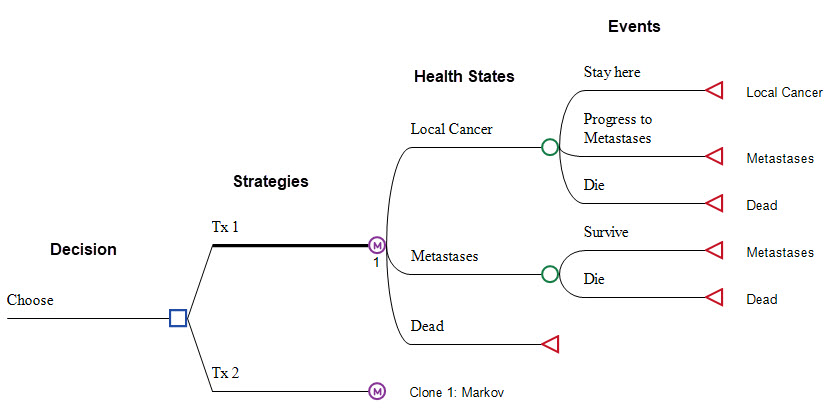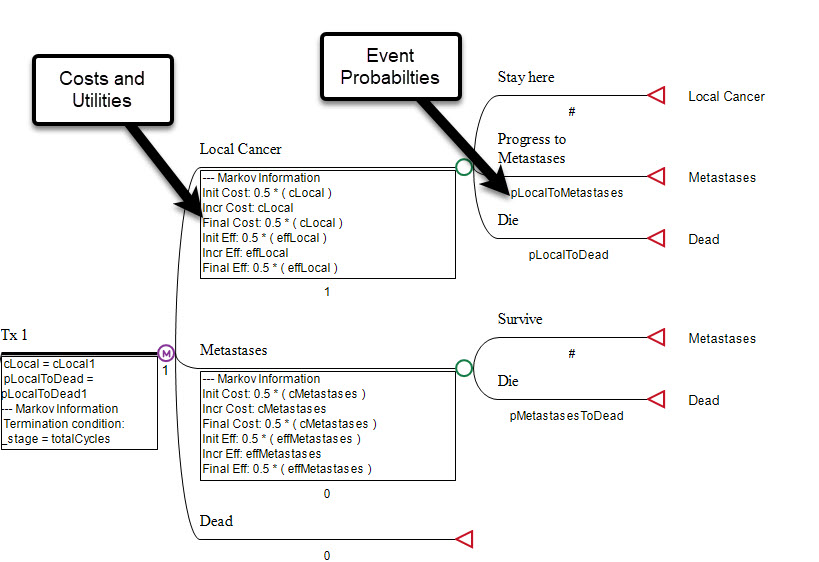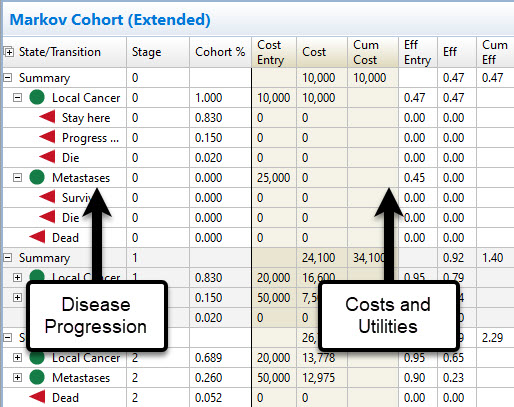Markov Models
TreeAge Pro is the premier Markov Modeling Software for Health Economics.
Build Markov models quickly and easily within TreeAge Pro’s visual modeling framework.
TreeAge Pro makes it easy to build Markov models – also known as a Markov chain models and state transition models.
Our Markov software includes a visual editor allows you to create a Markov tree diagram with patient pathways to model disease progression over time.
A simple, straightforward structure representing one cycle is automatically stretched out to a lifetime model.
Add health states and events
Add health states within the TreeAge Pro Markov framework directly to the right of the Markov node.
Add events to the right of each health state to create patient pathways for each Markov cycle.
Each patient pathway automatically ends with a referral back to a health state to start the next Markov cycle.
Enter event probabilities
Enter event probabilities directly under each event within the Markov framework. The probabilities can change over time.
As patients experience the events over time, the overall cohort is split among the states and events differently as time passes.
In a Markov Simulation Model, you can vary probabilities based on individual patient characteristics and/or patient history.
Enter costs and utilities
Add costs and/or utilities at any health state or event.
The costs and utility entries are automatically accumulated as patients passes through the model in each Markov cycle.
TreeAge Pro takes care of the calculations
Your health states, events, probabilities, costs and utilities are seamlessly integrated into model calculations.
As patients move through the states and events, costs and utilities are accumulated based on the percentage of the overall cohort that passed through that specific node in the model. The overall weighted-average of cost/utility from every health state and event in every cycle results in the average cost and utility per patient.
Markov Cohort Reports provide cycle-by-cycle details on disease progression cohort flow and the accumulation of cost and utility.
Built-in functions handle half-cycle correction and discounting within the Markov process.
Integrate with TreeAge Pro analysis tools
Extend your Markov model with additional analysis tools required for a robust modeling research project.
- Cost-Effectiveness Analysis
- Tornado Diagrams
- Probabilistic Sensitivity Analysis (PSA)
- Patient Simulation
Helpful Markov Modeling Tutorials
What is a Markov Model and why are they used for health economics?
Markov models allow you to model disease progression over time. For example, you might be modeling cancer which develops and progresses slowly over years. If you tried to model this with a simple Decision Tree rather than a Markov Decision Tree, you would have hundreds or thousands of nodes within the model to account for progression and other events in each year or month.
Markov models handle this seamlessly with a framework of health states and events. Patients start each cycle in a health state, then pass through event patient pathways within a time cycle. The patients are then sent back to the same or different states to start the next cycle. This allows a single progression event in the model to occur for different patients at different times in the future.
While the patients pass through the health states and events, they accumulate costs and utilities. Depending on the state, the cost for chronic care and the utility will be different. Costs may also be accumulated for events like hospitalization or screening. Markov Cohort Analysis accounts for the percentage of the overall patient cohort that passes through these health states and events to apply a weighted percentage to those cost/utility entries. The resulting sum of all weighted cost/utility values for all cycles is the average cost/utility per patient.
Markov models for health economics are frequently used to compare treatment/screening/diagnosis strategies for a specific health problem. These health economic models are run to calculate the average cost/utility of all strategies, which are then compared via cost-effectiveness analysis. This determines the most cost-effective strategy for the specific health problem.



